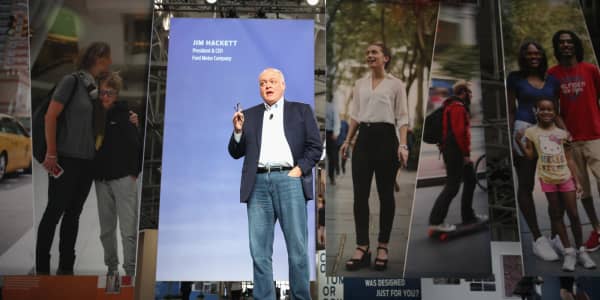Ever since internet business has been a thing, Amazon CEO Jeff Bezos has shown the world how to do it. Now Amazon's pending $13.7 billion deal to buy grocer Whole Foods Market promises to take Bezos' e-commerce evangelism to a new level. Amazon keeps making tangential moves that add to the mystery, such as a trademark registration for a meal-delivery system.
Lots of theories about the deal already have emerged, and they have implications for all businesses' survival in the Amazon era. The theories just haven't come from Amazon itself. The company's Thursday earnings call will be the first chance for analysts to ask Amazon about it — though probably not Bezos directly, who finally vaulted to position of world's richest man on Thursday. The last time Bezos was on an earnings call himself was in 2009. And with Amazon shares going up on the day the deal was announced by roughly the same amount as the $14 billion deal price, there's probably not much incentive for Bezos to make a guest appearance on the call to defend the acquisition — the market has already bought it, even if it doesn't yet understand it.
Here are five big ideas that may be aired with Amazon executives on earnings day that speak to a master plan for Amazon in the supermarket sector — and the lessons that can be gleaned from the online retailer's bold move.
1. It's just an extension of Amazon's existing experiment with groceries, and it's simply time to scale up.
Amazon has been testing two big grocery initiatives — Amazon FreshPickup, a service launched this year that lets Seattle-based consumers order groceries online and pick them up in as little as 15 minutes, and Amazon Fresh, which delivers produce and pantry staples through fulfillment centers in New York, California, Seattle and around Philadelphia.
The more obvious candidate to scale up is FreshPickup, which resembles services supermarket chains already offer. Amazon's big edge is that its data capabilities let it assemble orders much faster than supermarket chains can. But Bezos will have to prove that Amazon can do that as effectively across hundreds of stores as it has in Seattle. One thing that isn't likely to happen quickly: speculation that Amazon will use Whole Foods' stores as a national network of distribution centers for all kinds of goods. There simply aren't enough Whole Foods stores to make that happen, experts told Reuters.
Lesson: A successful local experiment may be a prerequisite to scaling up, but it is still a long way from ensuring a large-scale success.
2. Bezos wants to usher in the era of contactless retailing, similar to the Amazon Go store.
Amazon Go's calling card is that customers don't have to wait in line to pay for their purchases. Instead, they check into the store using a cellphone, open an Amazon app, and their phones keep track of what they take off the shelves and charge their Amazon accounts as the customers leave the store. Amazon is also looking at drive-through capabilities, the Wall Street Journal has said, as well as other formats. The stores, which resemble convenience stores, launched in Seattle this year.
Lesson: There's a reason Starbucks is making such a big deal out of mobile phone ordering, and fast-food executives at McDonald's and elsewhere are adopting ordering kiosks. The robots may not take all of our jobs tomorrow, but businesses need to be prepared for transactions that will increasingly lack human interaction.
3. Amazon wants an all-out price war on grocery suppliers.
This theory holds that Amazon will use leverage on suppliers, much as it did in the book business, to try to drive wholesale prices for groceries lower. Using size to drive price has always been part of Amazon's playbook. But if it were going to happen soon, that movement would be led by Wal-Mart, which has a much greater share of the supermarket business (by some estimates more than 20 percent) than Whole Foods (less than 2 percent) or Kroger (estimated at 8 percent). Any move Amazon might make in this area would help it boost margins and pay for Whole Foods faster, but wouldn't be likely to transform the grocery business more than Wal-Mart already has. Whole Foods' reliance on niche brands and private labels would weaken this argument further.
Lesson: Size matters, yes. But efficiency matters more.
4. Bezos wants to bring big data (even more) to the grocery business.
Supermarkets are already huge collectors of customer data through consumer loyalty and discount programs. Boston College adjunct professor Kenneth Sanford told CNBC that can be integrated with Amazon's Alexa and Echo businesses, bringing about the long-predicted day when refrigerators can know when you are out of milk and order more for delivery, or can know your preferences well enough to propose meal bundles a la Blue Apron. Maybe, but since some of us wrote that first prediction in 1999, we'll believe it when we see it. In the meantime, Amazon's existing purchase-tracking efforts are broadly similar to what land-based grocers do.
Consultant Stephen DiFranco wrote in Entrepreneur magazine that "presence marketing" would let Amazon track customers' movements in a store and tie their in-store behavior to their online moves. That in theory will let them offer useful suggestions, down to recipes to glaze the salmon in the seafood case. But that would likely take years to fine-tune.
Lesson: The Internet of Things may sound vague and tech-utopian preachy, but it's happening.
More from iCONIC:
America's food truck millionaires
Making 'bad' frozen food good again, and maybe worth billions
Warren Buffett's 10 commandments for corporate leaders
5. Amazon plans to remake the profit margins of the grocery business.
This theory holds that Amazon is bad news for other grocers, because "it will almost certainly accept lower profit margins than Whole Foods." Since Whole Foods spends only 66 cents of every sales dollar on its product (the remaining 34 cents is called its gross profit margin), that's likely.
But this means less than you might think. After spending on stores and overhead, swanky Whole Foods keeps 5 cents on each dollar as operating profit, and more mass-market Kroger keeps 3 cents. Amazon's retail business kept about 3.4 cents of the sales dollar as operating profit in the first quarter of 2017. So the notion that Amazon will cause brutal cost-cutting in an already competitive business doesn't look likely in the short term.
Lesson: Even efficient operators still want to make money, and pushing margins too low cheapens the prize you hope to win.
— By Tim Mullaney, special to CNBC.com




